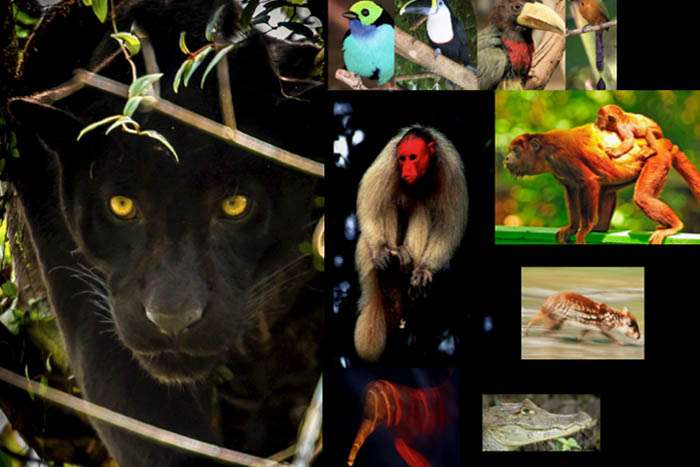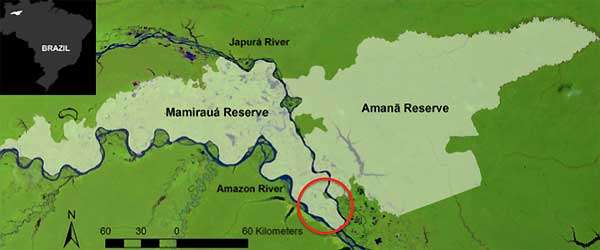Brazil, Spain and Australia join forces to revolutionise biodiversity monitoring in the Amazon

An international team of scientists from Brazil, Spain and Australia is developing the most sophisticated remote monitoring system ever used to track the diminishing biodiversity of South America's Amazon Jungle. The project Providence, which starts this week, is carried out by the Laboratory of Applied Bioacoustics (LAB) of the Universitat Politècnica de Catalunya · BarcelonaTech (UPC), the Mamirauá Sustainable Development Institute and the Federal University of Amazonas (UFAM), from Brazil; and the Commonwealth Scientific and Industrial Research Organisation (CSIRO), from Australia.
The high tech project Providence will revolutionise the way biodiversity is monitored by creating a distributed, wireless sensor network throughout the jungle with autonomous nodes that continuously monitor wildlife under the canopy of the Amazon Forest.
The international team has been granted US $1.4 million by the Gordon and Betty Moore Foundation, a philanthropic funding body established by Gordon Moore —the founder of Intel—to carry out the first stage of this biodiversity monitoring project.
The four research partners involved in Providence—the Laboratory of Applied Bioacoustics (LAB) of the UPC, from Spain, throw the Sense of Silence Foundation (TSOSF); the Mamirauá Sustainable Development Institute and the UFAM, Brazil, and the CSIRO, Australia— are meeting in Australia this week to commence phase one.
First species monitoring on a large scale
Amazon species are being extinguished at a faster rate than we can catalogue them, but accurate biodiversity assessments are difficult to obtain. "Remote sensing satellites and science aircraft provide a wealth of data about broad changes in forest cover, deforestation and land use, but these methods reveal almost nothing about the true story of biodiversity beneath the forest canopy," Emiliano Esterci Ramalho, Providence Project Coordinator, researcher and monitoring coordinator at the Mamirauá Institute in Brazil, said.
"Biodiversity assessments are difficult to carry out in rugged and remote areas using traditional methods. Researchers need to physically trek into the jungle and traverse a section of jungle to count the species they see and hear, and it can be quite dangerous as tropical rainforests are very inhospitable to humans. The result is not highly reliable nor comprehensive, and quite limited in terms of the information collected", tells Alberto Elfes, Providence Project Leader for Australia, Researcher at Commonwealth Scientific and Industrial Research Organisation (CSIRO).
"Our technological innovation for biodiversity monitoring in the Amazon is on a scale that hasn't been seen before, and will use multiple technologies including acoustics, visual imaging and thermal imaging to perform detection and identification of animals. In addition to the Amazon, these technologies will be highly valuable to forest biodiversity research worldwide," Ramalho added.

The aim is to conserve the ecosystem
Across the world, tropical forests are rapidly disappearing from our planet as a consequence of deforestation from activities such as logging, mining, expanding agriculture and urbanisation. Combined with global warming, the result is a dramatic increase in the rate of species extinction and loss of biodiversity.
The Amazon River Basin itself is home to the largest rainforest on Earth. The basin —roughly the size of the United States— covers some 40 per cent of the South American continent. This new technology will have a tremendous impact on measuring and preserving the Amazon's ecosystem, allowing researchers, governments and the public to understand and monitor the impact of changes in forest cover and biodiversity in the Amazon.
Emiliano Esterci Ramalho, researcher and monitoring coordinator at the Mamirauá Institute in Brazil, said the initial study area for Providence is at the southern end of the Mamirauá Reserve, between the Amazon and Japurá rivers. "One of the major concerns for scientists worldwide is biodiversity and the extinction of species. Having an accurate biodiversity assessment of an area such as the Amazon is essential because it can tell us about the impact of human activities in that natural environment", explains the researcher.
"We'll be collecting data from acoustic sensors (for underwater creatures, as well as terrestrial animals such as birds, frogs and monkeys), visual images, environmental data (wind, temperature, humidity, air pressure), and even thermal imagers. The animals that are of key interest in the initial trial stages are a range of species including jaguars, monkeys, bats, river dolphins, birds, reptiles and fish. In Phase one of Providence we will be field testing 10 trial monitoring devices in the Amazon, to create a wireless network of sensor nodes", Ramalho said.
Phase two will scale up to around 100 nodes installed in the Amazon basin and phase three will see up to 1000 nodes installed.
Michel André, founder and president of the TSOSF, director of the LAB, related to the Vilanova i la Geltrú School of Engineering (EPSEVG) of the UPC, and the Providence Project leader for Spain said: "Underwater passive acoustics monitoring of wildlife has experienced spectacular improvements in the last years due to new sensors developments as well as to the increased power of processing modules". For the first time, this technology, which was born in the complex ocean ecosystems to assess the effects of man-made noise on marine fauna, "is being applied to a large scale environment in the Amazon, for the conservation of terrestrial and aquatic creatures.", concludes the researcher.
The challenge is to handle live stream of data that contain sounds and images belonging to a tremendous number of known animals and probably as well as to several not-yet-discovered species, from the smallest bugs to the jaguars, going through acoustic signals from dolphins and fish.
"This unique biodiversity of sounds will be processed and streamed online so the scientific community and the general public can follow Providence progress and findings in real-time from home, through a specific interface. The magnitude of Providence implications to adapt to and manage future changes in the Amazon is simply comparable to the discovery of a hidden planet to humanity ", underlines Michel André.
Provided by Universitat Politècnica de Catalunya (UPC)